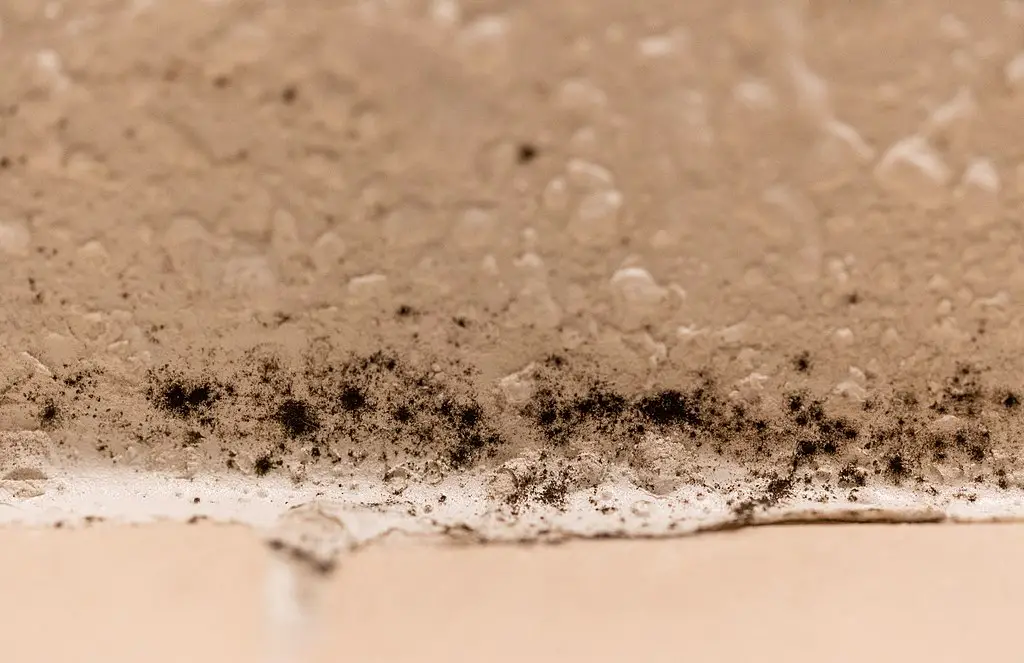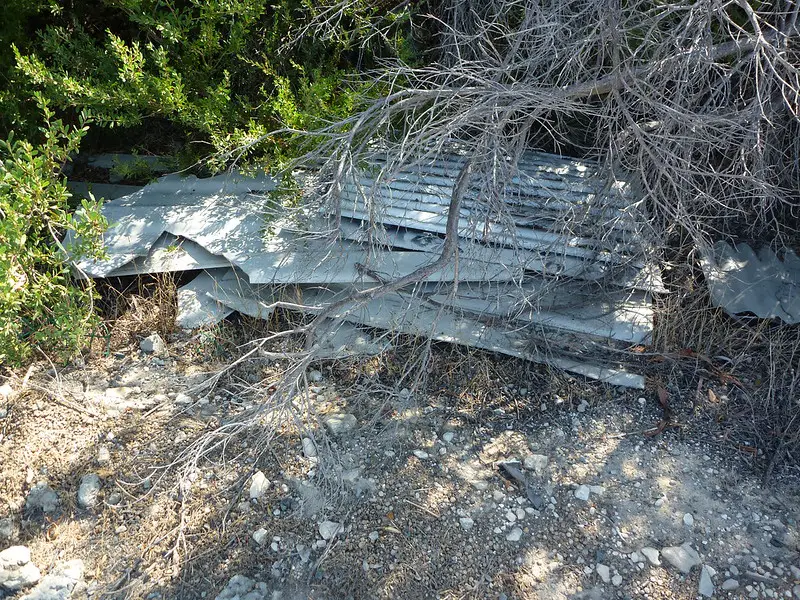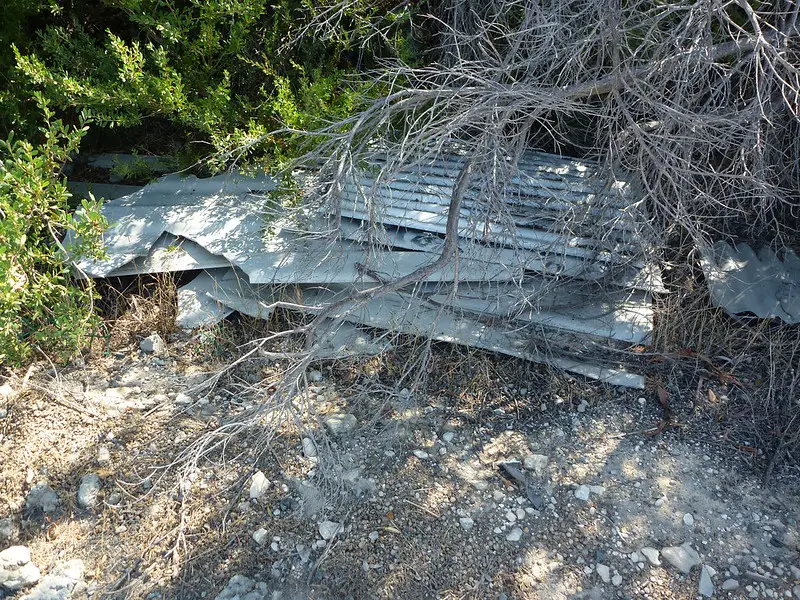Black mold, also known as Stachybotrys chartarum, is a type of fungus that thrives in damp and humid environments. asbestos is a mineral fiber commonly used in construction materials due to its fire-resistant properties
TL;DR Black mold Vs. Asbestos
Black mold can often be found in areas with water damage or excessive moisture, such as basements, bathrooms, or attics. Identifying black mold can be challenging since it may appear as dark green or black patches on surfaces like walls or ceilings.
Asbestos is a mineral fiber commonly used in construction materials due to its fire-resistant properties. Asbestos is most commonly found in older buildings (constructed before the 1980s) and was used extensively in insulation materials like pipes and tiles.
What is black mold?

Black mold, scientifically known as Stachybotrys chartarum, is a type of fungus that thrives in damp and humid environments. Unlike other types of molds that may appear green or white, black mold has a distinct dark appearance.
Black mold loves to grow on materials such as drywall, carpeting, insulation, and even household dust. It feeds on organic matter like wood or paper products and requires moisture to flourish.
What is asbestos?

Asbestos is a naturally occurring mineral that was widely used in various industries due to its heat resistance and durability. It can be found in building materials, such as insulation, flooring, and roofing. Asbestos poses serious health risks when disturbed.
Identifying asbestos-containing materials can be challenging since it is often mixed with other substances. However, older buildings constructed before the 1980s are more likely to contain asbestos-based products.
Black mold Vs. Asbestos – Key differences
| Key Differences | Black Mold | Asbestos |
|---|---|---|
| Definition | A type of mold | A group of naturally occurring minerals |
| Appearance | Black or dark greenish-black | Fibrous, can be white, gray, or other colors |
| Source | Thrives in damp, humid environments | Used in construction materials (e.g., insulation) |
| Health Risks | Can cause respiratory issues, allergies, and other health problems | Inhalation can lead to lung diseases, including mesothelioma |
| Removal | Mold remediation involves cleaning and eliminating moisture | Asbestos removal is complex and requires specialized abatement |
| Prevalence | Commonly found in areas with water damage | Often found in older buildings constructed before the 1980s |
| Regulation | Less regulated, but still considered a health concern | Highly regulated due to its severe health risks |
| Release into Air | Releases spores, which can become airborne | Releases fine fibers when disturbed or degraded |
| Inspection and Testing | Mold testing is less standardized | Asbestos testing is done by accredited laboratories |
How is mold formed and what are its sources?
- Moisture: The primary factor that leads to mold formation is moisture. Mold needs a damp or wet environment to grow and thrive.
- Organic Matter: Mold feeds on organic materials, such as wood, paper, fabric, and other natural substances.
- Poor Ventilation: Inadequate ventilation can trap moisture indoors, creating conditions suitable for mold growth.
- Warm Temperatures: Mold tends to grow in temperatures between 60°F (15°C) and 80°F (27°C).
- Indoor Air Quality: Mold grows in places with poor air circulation and filtration, mold spores may become more concentrated, increasing the chances of mold growth.
- Water Damage: Any area that has experienced water damage is highly susceptible to mold growth if the moisture is not promptly and properly dried.
Common sources of mold in indoor environments include:
- Leaky roofs or pipes: Water leaks from roofs or plumbing can create ideal conditions for mold growth in walls, ceilings, and other hidden areas.
- High humidity: Humid environments, like poorly ventilated bathrooms and basements, can encourage mold growth on surfaces.
- Flood damage: After a flood or water damage event, if the affected area is not thoroughly dried and cleaned, mold can quickly take hold.
- Damp or wet materials: Wet carpets, upholstery, and building materials, if not dried promptly, can become a breeding ground for mold.
- Condensation: Areas with high condensation, such as windows, can promote mold growth on surfaces.
Regular maintenance, proper ventilation, and addressing water issues promptly are essential in preventing mold growth and maintaining a healthy indoor environment. If you suspect a mold problem in your home or workplace, it’s important to address it promptly through proper remediation to minimize health risks.
How to identify mold?
- Visual Inspection: Look for visible signs of mold growth. Mold can appear in various colors, including black, green, white, brown, or gray.
- Water Damage: Mold frequently grows in areas that have experienced water damage or where there are leaks. Check for water stains, discoloration, or warping on walls, ceilings, and floors.
- Allergic Reactions: If you or your family members experience unexplained allergic symptoms like sneezing, coughing, wheezing, or skin rashes, it might be due to mold exposure. However, these symptoms can also be caused by other allergens, so it’s important to consider other factors as well.
- Musty Odor: Mold often produces a strong, musty odor. If you notice a persistent musty smell in your home, it could indicate the presence of mold.
- Hidden Areas: Mold can grow in hidden or hard-to-reach areas, such as behind walls, under carpets, and inside air ducts.
- Humidity and Dampness: Mold thrives in environments with high humidity and moisture.
- Mold Testing: If you suspect mold but cannot visually confirm it, you can opt for mold testing.
Health risks of mold
Exposure to mold can pose various health risks, especially for sensitive individuals and those with pre-existing respiratory conditions. The health effects of mold can vary depending on the type of mold, the extent of exposure, and individual susceptibility.
- Allergic Reactions: Mold spores can trigger allergic reactions in some people. Symptoms may include sneezing, runny or stuffy nose, itchy or watery eyes, skin rash or hives, and throat irritation.
- Respiratory Issues: Mold exposure can exacerbate respiratory conditions like asthma, causing asthma attacks or making existing symptoms worse.
- Irritation of the Skin, Eyes, and Throat: Direct contact with mold or its spores can cause skin irritation, redness, and itchiness.
- Hypersensitivity Pneumonitis: In rare cases, prolonged exposure to high levels of mold can lead to hypersensitivity pneumonitis, an inflammation of the lungs.
- Opportunistic Infections: Some molds produce mycotoxins, which are toxic substances that can be harmful when ingested, inhaled, or come into contact with the skin.
- Fungal Infections: Individuals with weakened immune systems, such as those undergoing chemotherapy or with HIV/AIDS, may be at risk of developing invasive fungal infections if exposed to certain types of mold.
It’s important to note that the severity of health effects can vary widely from person to person. Some individuals may experience mild symptoms or no symptoms at all, while others may suffer more severe health issues.
If you suspect mold growth in your home or workplace, it’s crucial to address the issue promptly and appropriately. Proper mold remediation should be conducted by professionals to ensure the safe removal and prevention of mold growth in the future.
The source of asbestos?
Asbestos is a naturally occurring mineral fiber that is found in certain rocks and soils. It is mined and processed into various products, including insulation, roofing materials, and brake pads.
The three main types of asbestos are:
- Chrysotile: This is the most common type of asbestos and is known as white asbestos. It is soft and flexible, and is often used in insulation and fireproofing materials.
- Amosite: This is a brown or black asbestos that is more brittle than chrysotile. It is often used in cement products and roofing materials.
- Crocidolite: This is a blue asbestos that is the most dangerous type of asbestos. It is very strong and resistant to heat, and was often used in gaskets and other high-temperature applications.
Asbestos fibers can be released into the air when asbestos-containing materials are disturbed, such as during demolition, renovation, or maintenance work. These fibers can be inhaled and can cause a number of health problems, including lung cancer, asbestosis, and mesothelioma.
The use of asbestos has been banned in many countries, including the United States. However, there is still asbestos present in many older buildings and structures. If you are concerned about asbestos exposure, you should contact a qualified professional to assess the situation.
Here are some of the sources of asbestos:
- Building materials: Asbestos was once used in a wide variety of building materials, including insulation, roofing materials, floor tiles, and textured paints.
- Automotive parts: Asbestos was once used in brake pads, clutches, and other automotive parts.
- Industrial products: Asbestos was once used in a variety of industrial products, including gaskets, packing, and filters.
- Naturally occurring asbestos: Asbestos can be found in certain rocks and soils.
If you are concerned that you may have been exposed to asbestos, you should contact a doctor or other healthcare professional. They can assess your risk and recommend appropriate treatment.
How to identify asbestos?
Identifying asbestos in your home or building requires caution, as it can be hazardous to your health when disturbed and released into the air. Asbestos is a group of naturally occurring minerals that were once commonly used in construction materials due to their heat resistance and durability. Here’s how you can identify asbestos:
Age of the Building: Asbestos was widely used in construction materials until the 1980s. If your building was constructed before the 1980s, there is a higher likelihood of asbestos-containing materials (ACMs) being present.
Asbestos Surveys and Inspections: To accurately identify asbestos, it’s best to hire a certified asbestos inspector or consultant to conduct a thorough asbestos survey. These professionals have the necessary training and equipment to safely collect samples for testing.
Visual Inspection: While not definitive, you can visually inspect materials for potential signs of asbestos. Common ACMs may include:
- Sprayed-on Insulation: Asbestos was often used as a fireproofing material in the form of a spray-on insulation coating on ceilings, walls, and structural components.
- Pipe Insulation: Asbestos insulation was commonly applied to pipes and boiler systems.
- Vinyl Floor Tiles: Some older vinyl floor tiles and adhesive glues used to install them may contain asbestos.
- Textured Ceiling (Popcorn Ceiling): Popcorn ceilings installed before the 1980s may contain asbestos.
- Roofing Materials: Asbestos cement was used in roofing shingles and siding.
Asbestos Test Kits: DIY asbestos test kits are available, but they may not be as accurate as professional testing. These kits usually involve collecting a sample and sending it to a laboratory for analysis.
Risk Assessment: If you suspect asbestos-containing materials, it’s essential not to disturb them. Asbestos poses a health risk when fibers become airborne and are inhaled. If the materials are in good condition and not disturbed, they may not be an immediate threat.
Remember, the only way to definitively identify asbestos is through laboratory testing of collected samples. It is crucial not to disturb or attempt to remove suspected asbestos-containing materials yourself, as this can release dangerous fibers into the air. Disturbing asbestos materials without proper precautions can be extremely hazardous to your health.
If you suspect asbestos in your home or building, it’s best to seek the help of professionals trained in asbestos assessment and abatement. They can safely collect samples and provide guidance on managing or removing asbestos-containing materials if necessary.
Health risks of asbestos
Exposure to asbestos can pose serious health risks to individuals, as it is a known carcinogen and can cause various respiratory diseases. The health effects of asbestos are primarily associated with the inhalation of asbestos fibers. When these fibers are released into the air and subsequently inhaled, they can become trapped in the lungs, leading to long-term health issues.
- Asbestosis: Asbestosis is a chronic lung disease caused by the buildup of scar tissue in the lungs due to long-term exposure to asbestos fibers.
- Lung Cancer: Asbestos exposure increases the risk of developing lung cancer. Smoking significantly compounds this risk when combined with asbestos exposure.
- Mesothelioma: Mesothelioma is a rare and aggressive cancer that affects the lining of the lungs, abdomen, or heart.
- Other Cancers: Asbestos exposure has been linked to an increased risk of other cancers, including cancers of the larynx, esophagus, stomach, colon, and rectum.
- Pleural Plaques and Effusion: Asbestos exposure can cause the formation of pleural plaques (thickened areas on the lining of the lungs) and pleural effusion (accumulation of fluid in the pleural space around the lungs).
- Diffuse Pleural Thickening: This condition involves the scarring and thickening of the pleura, the lining surrounding the lungs, which can restrict lung function and cause breathing difficulties.
- Gastrointestinal and Digestive Issues: Swallowing asbestos fibers can also cause gastrointestinal problems and may increase the risk of developing gastrointestinal cancers.
It’s important to note that the health risks of asbestos are dose-dependent and prolonged exposure to high levels of asbestos is most concerning. However, there is no known safe level of exposure to asbestos, and even minimal exposure can pose health risks over time.
To minimize the health risks associated with asbestos, it’s essential to take precautions when dealing with materials that may contain asbestos. If you suspect the presence of asbestos in your home or workplace, it’s crucial to have the material tested by a certified professional. If asbestos-containing materials need to be removed or disturbed, it should only be done by trained asbestos abatement professionals using proper safety procedures to avoid releasing asbestos fibers into the air.
Image Credits
Featured Image By – Harald Weber, CC BY-SA 3.0 , via Wikimedia Commons
Image 1 By – Tony Webster from Minneapolis, Minnesota, United States, CC BY-SA 2.0, via Wikimedia Commons
Image 2 By – Sam Wilson on Flickr









